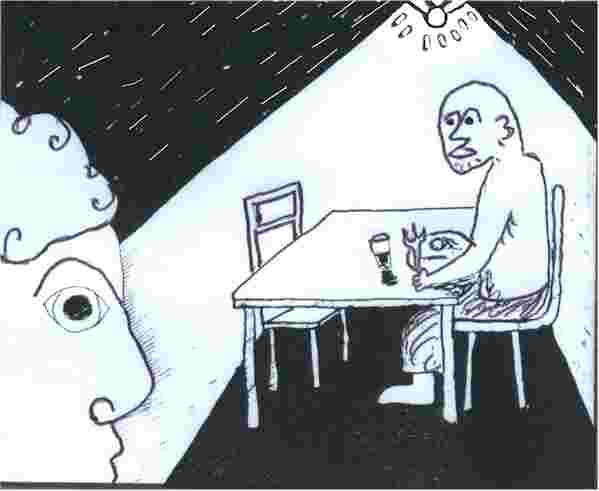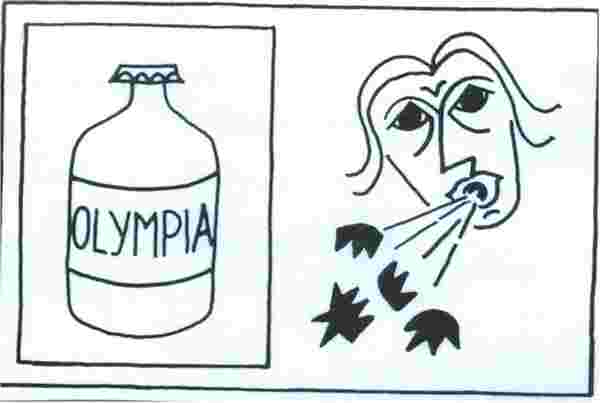
The Dream Story Game*
Henry Reed, Ph.D.
* This exercise originally appeared in The Sundance Community Dream Journal
We
know more about the meaning of our dreams than we are aware of or can put into
words. If we portray one of our dreams in a drawing, our hands will often reveal
some of the meaning of the dream. At first, however, we are still too close to
even our drawing of the dream to appreciate what our hands have revealed. It can
be helpful to give our drawing to someone else and, not telling them the dream,
drawing to someone else and, not telling them the dream, ask them to make up a
story about the drawing. The other person will unwittingly pick up on the clues
our hands have left behind and these clues will influence the story that
unfolds. The person's story may not particularly resemble the dream, but that
doesn't matter. If we are attentive to our emotional reactions to the story as
it is told, we might find that parts of the story, the words used, the themes
and the descriptions of the characters will trigger flashes of recognition of
the meanings in our dream.
That's the theory. Here's how it's done in practice:
The
game begins by having each person in the group make a drawing of a dream. We
allow perhaps 15 minutes for this, stressing that the purpose is not to create a
work of art, but rather to express the theme, the action or the mood of the
dream. The instructions are to make a single picture, not a series of cartoon
frames. The picture may be representative of the dream to the last detail or
simply an abstract expression of the dream. More important, however, is that
people make drawings to suit themselves and not be concerned about how other
people will react to them. Persons worried about their lack of "drawing ability"
can be honestly reassured that it won't matter - they'll have just as much fun
and get just as much out of it as the "artist."
While
the dreams are being drawn, it is helpful if people are quiet, so that they can
focus more energy into the drawings. It is also important that no one discuss or
reveal the nature of the dream that is being drawn.
The
finished drawings are collected and placed face down in the middle of the group.
Then each person receives someone else's drawing without knowing, ideally, who
the drawing belongs to. If the identify of the artist is known, we simply ask
that this information be ignored.
Instructions
are then given about making up a story about the drawing It needs to be made
clear that the object of the game is not to be able to guess what the dream was
about. Instead, the purpose is to enter the drawing with imagination and emerge
with a story that fits the drawing. Sometimes we say, "You can be most helpful
to the dreamer if you simply let your imagination have free rein and if you can
suspend critical judgment about your story-making skills." The instructions are
that the story answer the following questions: (1) What is gong on here? (2)
What are the people, animals or things feeling and thinking? (3) What led up to
the present situation? (4) How does it all work out?
We
give five minutes for people to meditate on the drawings. Then we begin to tell
the stories. Each person in turn tells a story and, while other people may wish
to comment or obtain further details of the story, the identity of the dreamer
(the person who did the drawing) is not revealed. In this part of the game the
focus is on the stories.
Sometimes
the person telling the story needs some help. Helping the story teller requires
that the other people be sensitive tow hat is going on with the person as the
story is told. Sometimes the story teller lacks confidence, making only brief
comments that don't quite form the story. The group can offer support, coaching
by asking specific questions about the drawing until a story emerges. It is
helpful to give reassurance that it is not the story-telling skill that helps
the dreamer, but rather the person's willingness simply to tell what they are
reminded of by the drawing. Should the story teller remark, "I don't know what
is happening here; maybe these people are doing this, maybe they are doing
that..." a helpful reminder is that it is not the purpose of the game to be able
to guess what the dream was about, but to simply pretend they do know what is
going on in the picture and to tell the story.
Sometimes
a person will not tell a story, but instead, will make evaluative comments about
the dreamer who made the drawing: "The heaviness of these strokes shows that the
dreamer is a very determined person." This kind of evaluation has to be curbed.
Encourage the person to shift their sensitivity from the drawing style to the
story they make up.
I
make these comments only as a precaution, in case such problems arise, for they
sometimes do. Yet for the most part, people have a natural tendency to make up a
story about the drawing - it is child's play.
After
the stories have been told, the dreamers identify themselves in turn, tell their
dreams, and give their reactions to the stories. Sometimes the dreamer needs
some help, too. It is natural to compare the original dream with the story told
about the drawing. The dreamer may say, "Well, you were right about this part,
but wrong about that part." That's fine, but misses the point of each game.
The
dreamer can be helped along with questions such as (1) What did you learn about
your dream from hearing the person's story? (2) Did the story remind you or help
you become aware of any feelings you had about your dream? (3) Did the story
remind you of anything about yourself?
In
the discussion period there are often discovered provocative connections between
the story, the dream, the story teller and the dreamer. It may be that the story's
theme strikes a deep chord within the dreamer, perhaps revealing the essence of
the meaning of the dream. More often it is just one aspect of the story that
speaks to the dreamer, creating a new awareness about the meaning of some part
of the dream. If the story teller is asked to try to reconstruct how the drawing
stimulated the story that was told, it may be learned that it was the color, the
shading, the placement, etc. that seemed significant. The dreamer then may come
to recognize the way they expressed themselves with their hands and get in touch
with the new levels of meaning. Sometimes the story proves to be a remarkably
accurate "reading" of the dreamer in some way, leaving the group marveling at
the mystery of "where the story came from." There is no way of predicting in
advance the kind of insights that will emerge from the discussion. So it is best
to allow the discussion period to be freewheeling, led by curiosity and a
respect for the truth contained in the feelings.
At
the end of the discussion period, it is important that people spend some time
with themselves, writing in their journals about their experience. The purpose
to encourage people to "own" what they have learned. The story teller tells a
story in "innocence." If the dreamer finds some truth in the story, it is truth
recognized from within. Writing about what has been recognized will diminish any
tendency to attribute the wisdom to someone else and make it easier to discard
anything that doesn't really ring true.
Now
I want to give two examples of my own dream drawings to show how the stories can
be helpful.
The first drawing portrays a dream where I enter a restaurant and see a man seated alone at a table. Our eyes make contact and a woman's voice whispers in my ear that I should sit down at the table with the man. I refuse.

The story that was told about this drawing concerned an artist at work in his studio. I forget the rest of the story, actually, because even at the time, it was the mention of "artist" that hit me strongly. Like most people, no doubt, I would like to develop the "artist" within me, so I was startled to suppose that the person in my dream whom I had rejected might have something to do with the artist. The story teller explained that it was the "unkempt appearance" of the person in the drawing that had suggested the role of artist. That remark made me aware that in the dream it was the man's appearance that I had used as my excuse for not sitting with him. That moment of honesty led to further discoveries about how I cut off the flow of creativity by imposing arbitrary standards of social acceptability. This particular dream story game had a profound and lasting effect on me, leading to my involving myself in practicing art, which you can see at www.henryreed.com/artgallery
The second picture portrays a dream where I see a magazine ad for "Olympia" beer. I tear out the picture of the bottle of beer and eat it. the picture turns into a real bottle and I spit out pieces of glass.

The
story that was told concerned a person undergoing a period of purification. This
person had gone to Mount Olympus to obtain special healing water. The water was
having a purgative effect, inducing the person to vomit up the impurities in the
body. In this story, it was the word "water" that rang the bell. The trademark
slogan for Olympia beer is, "It's the water." I had "forgotten" that until the
story was told, but then instantly realized that the slogan revealed the meaning
of the dream. I had "forgotten" that until the story was told, but then
instantly realized that the slogan revealed the meaning of the dream. I had been
in a process of trying to learn the meaning of the dream. I had been in a
process of trying to learn the meaning of alcohol in my life (you can read the
story of how dreams initiated my recovery from alcoholism at www.henryreed.com/dreamquest/henry.htm
). In this dream that I drew, I seem to be purging myself of any superficial or
literal understanding, learning that by mistaking the image for the meaning, I
would be incorporating something too concrete. I needed to purge myself of the "bottle"
so that I could learn that it was really the "water" that I was seeking. Here is
a good example of a story told in innocence that really hit the mark and had a
healing effect. It's also a good lesson about the mistake of taking an image too
literally. Later you may have to
spit it out!
Perhaps these two examples show something of the special value the dream
drawing story game can have. What I like about it is that by telling a story
about the drawing, most anyone can be helpful to the dreamer. The game bypasses
the intellect and relies on the intuitive processes in the story teller. In this
way, theoretical interpretations, which often result in making judgments about
the dreamer, are avoided. Besides, any interpretation of a dream is really
another dream about a dream. In the dream drawing story game this fact is "up
front," for it is obvious that the story teller is making self-revelations in
making up the story. Rather than by making diagnostic judgments, when people try
to help one another by making self-revelations, the result is usually a more
mutually supportive and healing atmosphere.